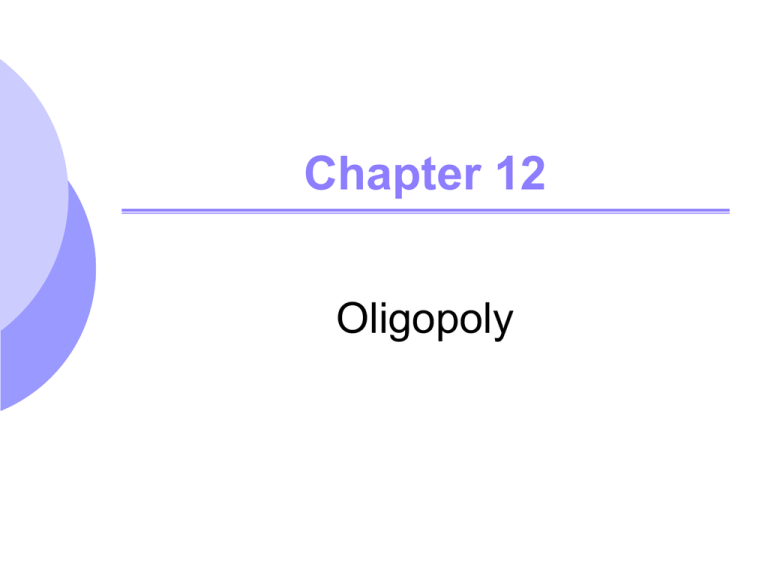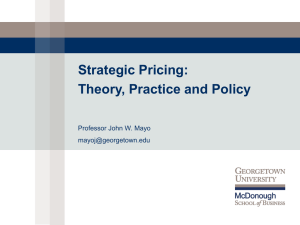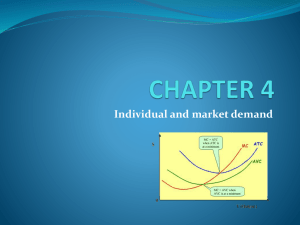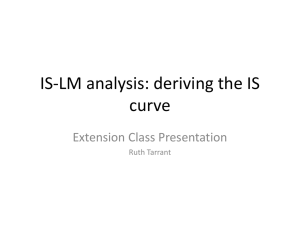Oligopoly
advertisement

Chapter 12 Oligopoly Oligopoly – Characteristics Small number of firms Product differentiation may or may not exist Barriers to entry Chapter 12 2 Oligopoly – Equilibrium Defining Equilibrium Firms are doing the best they can and have no incentive to change their output or price Nash Equilibrium Each firm is doing the best it can given what its competitors are doing. Chapter 12 3 Duopoly The Cournot Model Oligopoly model in which firms produce a homogeneous good, each firm treats the output of its competitors as fixed, and all firms decide simultaneously how much to produce Firm will adjust its output based on what it thinks the other firm will produce Chapter 12 4 Firm 1’s Output Decision P1 Firm 1 and market demand curve, D1(0), if Firm 2 produces nothing. D1(0) If Firm 1 thinks Firm 2 will produce 50 units, its demand curve is shifted to the left by this amount. MR1(0) D1(75) If Firm 1 thinks Firm 2 will produce 75 units, its demand curve is shifted to the left by this amount. MR1(75) MC1 MR1(50) 12.5 25 D1(50) 50 Chapter 12 Q1 5 Oligopoly The Reaction Curve The relationship between a firm’s profitmaximizing output and the amount it thinks its competitor will produce. A firm’s profit-maximizing output is a decreasing schedule of the expected output of Firm 2. Chapter 12 6 Reaction Curves and Cournot Equilibrium Q1 Firm 1’s reaction curve shows how much it will produce as a function of how much it thinks Firm 2 will produce. The x’s correspond to the previous model. 100 75 Firm 2’s Reaction Curve Q*2(Q2) Firm 2’s reaction curve shows how much it will produce as a function of how much it thinks Firm 1 will produce. 50 x 25 x Firm 1’s Reaction Curve Q*1(Q2) 25 50 x 75 Chapter 12 x 100 Q2 7 Reaction Curves and Cournot Equilibrium Q1 In Cournot equilibrium, each firm correctly assumes how much its competitors will produce and thereby maximize its own profits. 100 75 Firm 2’s Reaction Curve Q*2(Q2) 50 x 25 Cournot Equilibrium x Firm 1’s Reaction Curve Q*1(Q2) 25 50 x 75 Chapter 12 x 100 Q2 8 Cournot Equilibrium Each firms reaction curve tells it how much to produce given the output of its competitor. Equilibrium in the Cournot model, in which each firm correctly assumes how much its competitor will produce and sets its own production level accordingly. Chapter 12 9 Oligopoly Cournot equilibrium is an example of a Nash equilibrium (Cournot-Nash Equilibrium) The Cournot equilibrium says nothing about the dynamics of the adjustment process Chapter 12 10 Oligopoly: Example An Example of the Cournot Equilibrium Two firms face linear market demand curve Market demand is P = 30 - Q Q is total production of both firms: Q = Q1 + Q2 Both firms have MC1 = MC2 = 0 Chapter 12 11 Oligopoly Example Firm 1’s Reaction Curve MR=MC Total Revenue : R1 PQ1 (30 Q)Q1 30Q1 (Q1 Q2 )Q1 30Q1 Q12 Q2Q1 Chapter 12 12 Oligopoly Example An Example of the Cournot Equilibrium MR1 R1 Q1 30 2Q1 Q2 MR1 0 MC1 Firm 1' s Reaction Curve Q1 15 1 2 Q2 Firm 2' s Reaction Curve Q2 15 1 2 Q1 Chapter 12 13 Oligopoly Example An Example of the Cournot Equilibrium Cournot Equilibriu m : Q1 Q2 15 1 2(15 1 2Q1 ) 10 Q Q1 Q2 20 P 30 Q 10 Chapter 12 14 Duopoly Example Q1 30 Firm 2’s Reaction Curve The demand curve is P = 30 - Q and both firms have 0 marginal cost. Cournot Equilibrium 15 10 Firm 1’s Reaction Curve 10 15 Chapter 12 30 Q2 15 Oligopoly Example Profit Maximization with Collusion R PQ (30 Q)Q 30Q Q MR R Q 30 2Q MR 0 when Q 15 and MR MC 2 Chapter 12 16 Profit Max with Collusion Contract Curve Q1 + Q2 = 15 Shows all pairs of output Q1 and Q2 that maximizes total profits Q1 = Q2 = 7.5 Less output and higher profits than the Cournot equilibrium Chapter 12 17 Duopoly Example Q1 30 Firm 2’s Reaction Curve For the firm, collusion is the best outcome followed by the Cournot Equilibrium and then the competitive equilibrium Competitive Equilibrium (P = MC; Profit = 0) 15 Cournot Equilibrium Collusive Equilibrium 10 7.5 Firm 1’s Reaction Curve Collusion Curve 7.5 10 15 Chapter 12 30 Q2 18 First Mover Advantage – The Stackelberg Model Oligopoly model in which one firm sets its output before other firms do. Assumptions One firm can set output first MC = 0 Market demand is P = 30 - Q where Q is total output Firm 1 sets output first and Firm 2 then makes an output decision seeing Firm 1 output Chapter 12 19 First Mover Advantage – The Stackelberg Model Firm 1 Must consider the reaction of Firm 2 Firm 2 Takes Firm 1’s output as fixed and therefore determines output with the Cournot reaction curve: Q2 = 15 - ½(Q1) Chapter 12 20 First Mover Advantage – The Stackelberg Model Firm 1 Choose Q1 so that: MR MC 0 R1 PQ1 30Q1 - Q - Q2Q1 2 1 Firm 1 knows that firm 2 will choose output based on its reaction curve. We can use firm 2’s reaction curve as Q2 Chapter 12 21 First Mover Advantage – The Stackelberg Model Using Firm 2’s Reaction Curve for Q2: R1 30Q1 Q12 Q1 (15 1 2Q1 ) 15Q1 1 2 Q12 MR1 R1 Q1 15 Q1 MR 0 : Q1 15 and Q2 7.5 Chapter 12 22 First Mover Advantage – The Stackelberg Model Conclusion Going first gives firm 1 the advantage Firm 1’s output is twice as large as firm 2’s Firm 1’s profit is twice as large as firm 2’s Going first allows firm 1 to produce a large quantity. Firm 2 must take that into account and produce less unless it wants to reduce profits for everyone Chapter 12 23 Competition Versus Collusion: The Prisoners’ Dilemma Nash equilibrium is a noncooperative equilibrium: each firm makes decision that gives greatest profit, given actions of competitors Chapter 12 24 Competition Versus Collusion: The Prisoners’ Dilemma The Prisoners’ Dilemma illustrates the problem that oligopolistic firms face. Two prisoners have been accused of collaborating in a crime. They are in separate jail cells and cannot communicate. Each has been asked to confess to the crime. Chapter 12 25 Payoff Matrix for Prisoners’ Dilemma Prisoner B Confess Confess Prisoner A Don’t confess -6, -6 Don’t confess 0, -10 Would you choose to confess? -10, 0 Chapter 12 -2, -2 26 Oligopolistic Markets 1. 2. 3. Conclusions Collusion will lead to greater profits Explicit and implicit collusion is possible Once collusion exists, the profit motive to break and lower price is significant Chapter 12 27 Price Leadership The Dominant Firm Model In some oligopolistic markets, one large firm has a major share of total sales, and a group of smaller firms supplies the remainder of the market. The large firm might then act as the dominant firm, setting a price that maximizes its own profits. Chapter 12 28 Price Setting by a Dominant Firm Price SF D The dominant firm’s demand curve is the difference between market demand (D) and the supply of the fringe firms (SF). P1 MCD P* DD P2 QF QD QT MRD Chapter 12 At this price, fringe firms sell QF, so that total sales are QT. Quantity 29






